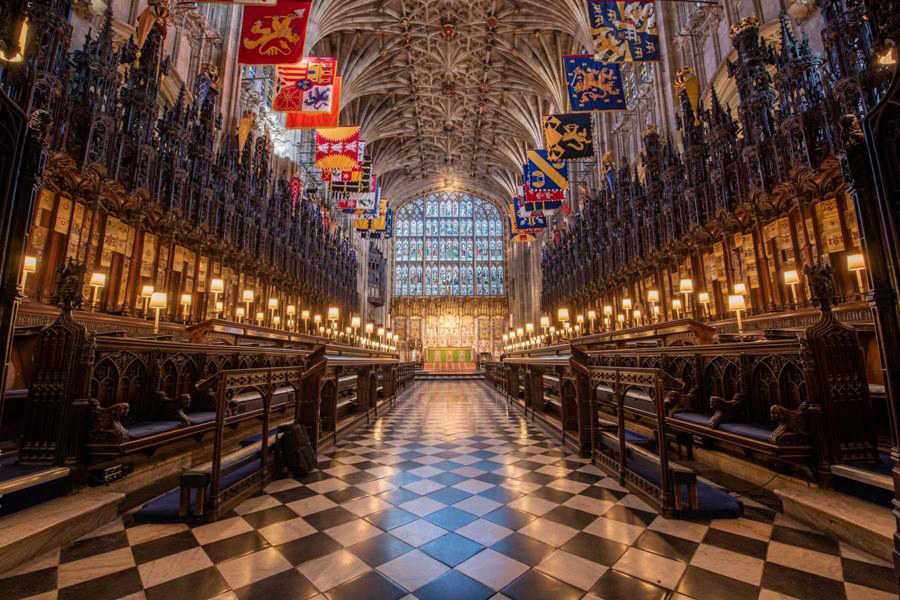Whitwam delivers St George's Chapel AV upgrade
- Details

Originally built in the 15th century by King Edward IV, the chapel has been the scene of many royal services and weddings.
Whitwam AV Integration has installed a modern and sympathetically styled audio-visual system that has transformed the way that words and music are experienced throughout the building, blending with the magnificent and historically rich setting.
The loudspeaker system from K-array focuses on providing superior vocal intelligibility in what is a generally challenging acoustic environment with a typical RT60 of three or four seconds, so the audio design emphasised the placement of sources relatively close to the listener to increase direct sound and reduce reflections. Vyper half-metre long line arrays form the nucleus of the widely distributed loudspeaker system for the nave, with low frequency reinforcement from Rumble-KU44 subwoofers hidden behind grilles in the floor where the old heating pipes had once been.
“Since the previous sound system went in over 10 years ago audio technology had moved on considerably, and with it the need to improve sound delivery in the chapel. Our acoustic measurements highlighted areas of seating that suffered from reduced intelligibility," says Andrew Pymm, director, Whitwam AV Integration
Each of the pillars lining the nave carries Viper-KV52 line arrays; single enclosures on the outsides facing into the side aisles, and double-stacked enclosures directed at the seating areas to give additional throw towards the middle of the building.
Floor-mounted Kobra-KK52 line arrays are placed for additional sound reinforcement in the Bray and Rutland chantry chapels, and at left and right of the high altar at the east end of the quire.
To accommodate the acoustic delay down the building the K-array speakers are paired up on amplifier channels and fed with delayed audio, while channel interleaving redundancy built into the speaker assignment avoids widespread loss of audio in the event of an amplifier failure.
Opportunities for speaker locations in the choir areas were limited to near-field options. “For the majority of seating locations, the JBL Control 52s worked well but didn’t quite fit visually in all areas, so we put in additional K-array Lyzard-KZ1s on the choir stall upstands and, thanks to their very compact dimensions they simply disappear amongst the woodwork,” explained Pymm.
The heart of the signal processing system is a Dante enabled QSC Q-SYS Core510i control processor with analogue audio input and output cards, providing microphone switching and volume level adjustment all managed by the Crestron system.
“Crestron touchscreens provide the intuitive user interface that enables the staff – who are non-technical – to switch on the audio system with one touch and assign sources to various zones using a graphical representation of the building,” says Pymm.
The three central equipment racks located in the south quire aisle house a comprehensive array of hardware that allows operation and monitoring of the whole audio/video system from a central point, including the Yamaha power amplifiers, Crestron touch screen and Marshall video monitors, Fostex RM3 monitor speaker, and Tascam SS-CDR250N multi-format audio recorder that also allows music tracks to be cued up and played remotely.
The organ loft has its own dedicated sound and vision facility with a Crestron touch screen, JVC zero latency video monitor and pair of KEF monitor speakers, so allowing the organist to see and hear everything and with the ability to adjust audio levels if need be. A pair of Panasonic AW-UE70 4K PTZ high-definition cameras with pre-set view positions are installed in the organ loft.
Providing voice capture duties are microphones from Audio-Technica; mostly ES935ML6 microline capsules on custom mounts designed with a push-to-talk switch and a status LED for self-operation, in various locations around the building and within the woodwork and fabric of the quire. Sennheiser 2000 series radio mics allow for hand-held or stand mounted use anywhere in the building, while for music duties Sennheiser MKH8040 condenser microphones are partially hidden behind the speakers in the nave for picking up the choir so that the organist can hear them clearly.
“The key to success at St George’s Chapel has been the way that the equipment all fits together so seamlessly to overcome the acoustic and visual challenges they had in the past, and the simplicity with which it can be operated given the vast range of different events that routinely happen in the chapel,” concludes Pymm. “The staff don’t have to worry or even think about the technology, it all just works quietly and neatly in the background.”
















